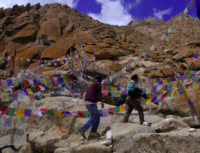

Waterline is an ongoing series that explores the solutions making rivers, waterways and ocean food chains healthier. It is funded by a grant from the Walton Family Foundation.
Autumn colors burnish the willows and poplars in Ladakh, a remote valley sandwiched between the Greater Himalayan and Karakoram mountain ranges in Northern India. Farmers prepare for the harvest of wheat, potatoes and barley in fields flanked by snowy peaks and glaciers. In the summer and autumn, these melt and provide much-needed water for drinking and irrigation downstream.
But in the spring, when Ladakhi farmers sow their summer crops, many face an acute water shortage: the glaciers high above them are still frozen, and the region is a high-altitude desert that receives only about 11 centimeters of precipitation annually.
Up until a few years ago, this water scarcity — at dizzying altitudes between 3,000 and 6,120 meters, and with temperature extremes swinging all the way from -28 to 33 degrees Celsius — compelled many farmers to give up farming altogether.

“We used to face such acute water shortages in March and April in our village that we had to migrate to a neighboring village with better water supply,” says Kunzang Namgyal, resident of Kulum, a tiny village 50 km north of Leh (the capital of Ladakh). The settlement of 11 families, all dependent on agriculture and livestock rearing, used to be an oasis of green surrounded by craggy, arid mountains. But since 2010, water scarcity has turned it into a ghost village. “We wanted to keep our connection with the land of our ancestors alive,” he says. “But how?”
In 2013, Ladakhi educator and inventor Sonam Wangchuk came up with a surprising way to relieve this seasonal problem. He had noticed that ice stalagmites remained solid long after horizontal ice around them had melted. Was it possible that when frozen vertically, ice took longer to melt than when it lay flat on the ground? And could this be a viable way to store water to tide farmers over the spring drought?
Wangchuk began experimenting with building ice into pyramids in winter to see how long they took to melt. Because they looked similar to the conical Buddhist stupas — shrines that contain relics of holy men and women, or even sacred mantras, ubiquitous across the Ladakhi landscape — they came to be called ice stupas. Their recognizable shape would, Wangchuk surmised, blend seamlessly with their surroundings and make people identify with them more easily.
Cut to the campus of Students’ Educational and Cultural Movement of Ladakh (SECMOL), a school that Wangchuk founded in 1988 for students who failed their public board examinations in grade 10.
“We chose a spot with a southern exposure located at the lowest altitude (hence warmest) possible in the whole of Leh valley to develop our ice stupa prototype,” the engineer and passionate education reformer recounts. “If our model could succeed in these inhospitable, hot and shadeless conditions, it would work anywhere in Ladakh.”

Within a month, Wangchuk and his team built a seven-meter-high structure, without using any electricity and with minimal labor. They piped water from a height of over 60 meters uphill, calculating that it would rise like a fountain an equal distance up from the ground when piped downstream. Sub-zero winter temperatures would do the rest.
Reliving those initial experiments, he says, “We’d hoped the prototype would last till 1st May, but it did better than that!” It finally melted on May 18, giving him, and his cohort at Himalayan Institute of Alternatives Ladakh (HIAL), a research and training facility he founded in 2017, proof of concept and the hope that this could partially remedy the annual spring drought plaguing farmers in Ladakh.
The farmers themselves were initially skeptical. “Of the 11 households in Kulum village, five felt that this ice stupa idea would not work,” Namgyal says. “No one had ever thought of storing water in ice before.”
At HIAL, where scientists research and develop technologies suited for higher altitudes, scientists worked for the next few years to make ice stupas more thermally efficient and easier to build. Two distinct designs emerged from these experiments. The first connects to a tank, which stores the ice melt and pipes it into fields. The second simply recharges the surrounding area as it melts. Both help to reduce the dry conditions that Ladakh experiences and make cultivation possible.
“The initial cost of setting up an ice stupa — pipes, joiners, labor and fuel included — is about US $1,500,” Nishant Tiku, faculty member and ice stupa project coordinator at HIAL, says. “But this equipment is not only reused again and again for making fresh ice stupas [during] the successive winters, it is also used every spring to pipe the meltwater to the fields.” The ice stupas are low-cost, low-tech and do not melt as quickly as horizontal ice as their conical shape decreases the surface area exposed to the sun.
Wangchuk won the Rolex Award for Enterprise in 2016 for his ice stupa design, and he intended to use the prize money to build up to 20 ice stupas, each 30 meters high, in Ladakh. However, closer to home, disputes over water sharing created initial roadblocks for the project.
Weighed down by negative news?
Our smart, bright, weekly newsletter is the uplift you’ve been looking for.“Ladakhi villages along streams and other water sources have age-old water-sharing agreements to ensure equitable access to water,” Wangchuk explains. “Unfortunately, some villagers downstream objected to our using springwater to build ice stupas, even though we only wanted the water in winter, when the villagers’ requirement for it is negligible.” This perceived violation of the water use practices of the village has hampered their objective to build as many ice stupas as they would have liked, but here too, the folks at HIAL found a creative solution.
“We thought, why not train people to build their own ice stupas in their villages?” says Wangchuk. In 2018, using his award money and crowdfunding, he spearheaded an annual ice stupa making contest in which teams from across Ladakh participated for cash awards ranging from US $2,500 to $6,000. Thus far, five statewide contests have each attracted around 15 teams, all vying to build the tallest ice stupa that stores the maximum amount of water. “This way, we’ve engaged with over 45 villages in the state,” Tiku says, “and trained over 500 stakeholders to build ice stupas and experience their benefits.”

In Kulum, Namgyal and the five other families have become enthusiastic ice stupa builders. He says their annual potato harvest has substantially improved thanks to the availability of water in spring. “This year, we harvested over 3,500 kilograms of potato, enough to feed our families and sell in the market,” Namgyal says. “Before we started building ice stupas, this would have been unimaginable.”
There is a historical precedent for using artificial glaciers to store water in Ladakh: Accounts of communities in the High Himalayan ranges practicing “glacier grafting” date back to the 13th century. People would break ice at lower altitudes and store it higher up, hoping that the newly grafted glacier would feed their streams in the summer. The story goes that locals actually tried to do this to stall the advance of Genghis Khan’s army.
More recently, in 1987, Ladakhi civil engineer Chewang Norphel successfully diverted glacial meltwater into an artificial lake on the shaded sides of a mountain. This mass of ice grew when new water flowed into the lakes. In spring, its meltwater recharged the streams below.
But ice stupas, thanks to the way their vertical orientation slows down melting, are particularly well-suited as a solution for farmers facing seasonal drought. And they are beginning to be replicated beyond Ladakh: In 2022, Chilean engineers built the first ice stupa prototype in the Andes and are now working on a scalable AI-based model that will use rainfall patterns, climate data and several other indicators to optimize its efficiency.
However, artificial glaciers, including ice stupas, have limitations, Tiku points out. They can only be built at altitudes above 4,000 meters, where the temperatures are low enough for them to stay frozen until spring. They are vulnerable to destruction from flash floods and heavy rainfall, and need to be located in a north-facing valley to shade the ice from the spring sun.
Yet they hold lessons that might even be useful in our protection of natural glaciers. In the Swiss Alps, Wangchuk and his team have been working with glaciologists to find out if by converting glacial meltwater into snow (now known as meltwater recycling), they can delay, if only partially, the recession of glaciers despite rising temperatures. Mathematical modeling shows that under today’s conditions, it would be possible for glaciers to grow in length in 10 years if 10 percent of the glacier area were covered with snow all year round.
While the jury is still out on whether artificial glaciers can actually bolster natural glaciers, in Ladakh, Wangchuk and Tiku have been working on another, more tangible idea: perennial ice stupas. “So far, two of our ice stupas lasted over a year before they melted,” Tiku says. “We’re trying to improve their thermal efficiency so that every year, they last all summer and are naturally recharged by the winter snow.” If they succeed, their ice stupas could potentially become new glaciers, and more sustainably address the needs of Ladakhi farmers.
Meanwhile, Namgyal and his neighbors are planning for the upcoming ice stupa contest this winter. “My school-going children want to help as well,” he says. “We want to win this time, and it’s not just for the prize — it’s to ensure that next year, too, our harvest is as good as this year’s.”






